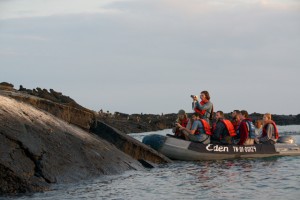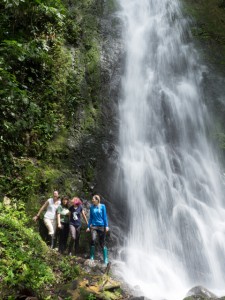CSUN Science Students Tread to South America with Tropical Biology Program

CSUN biology students explore the Galapagos Islands during a two-month study abroad program last spring. Photo provided by Tim Karels
It is hard to imagine more than 600 species of trees thriving within a 100-square-meter space unless it is seen up close. California State University, Northridge biology students get the opportunity to explore the diverse Tropics of South America through the Tropical Biology Program.
Run by CSUN biology professor Fritz Hertel, the program gives students who have oftentimes never left the state an up close experience with the diversity of life on earth.
“Most of the people that have come through the program have never left Southern California, he said. “They have their cell phones and their televisions right here, but there is a whole new world out there to explore.”
Up to 15 CSUN students venture out to Ecuador, where they traverse the Andean cloud forests, the Amazon Basin and the Galapagos Islands every other year for two months. They study the biodiversity of the regions and collect data. Upon returning to campus, each student creates two papers and presentations with his or her data findings, Hertel explained.
The students receive more than just an ecological experience, Hertel said. With more than 20,000 acres of rainforest being cut every day, showing students the high biodiversity and vitality of the Tropics is a way to show why preserving it is vital.
“Many parts of [the tropics] are endangered, they are cutting it down,” he said. “One of the places we go to is fairly isolated, but it is being threatened by the petroleum business.”

CSUN biology students explore the tropics in South America every other year. Photo provided by Tim Karels.
Tim Karels, a CSUN ecology professor, usually studies arctic biodiversity, but has taken an interest in the tropics because of how much there is to explore.
“I’m not a tropical biologist, I’ve mostly worked in the arctic,” Karels said. “It’s very different. Arctic ecosystems are very simple. There are maybe four species of trees in 10,000 hectares. In Ecuador, there can be up to 600 species of trees in just one hectare. The diversity is truly astounding.”
Hertel has been to the Tropics many times, yet he still finds something new to explore with each trip.
“I love travelling there,” he said. “The diversity means there is always something new to explore.”
“And there are organisms in the Tropics that have yet to be classified and documented by science,” Karels added.
Yet the most magnificent experience of the program is seeing the students grow from the exploration.
“You see a lot of the students blossom,” Hertel said with a smile. “They get excited, they appreciate the nature of it.”

 experience
experience